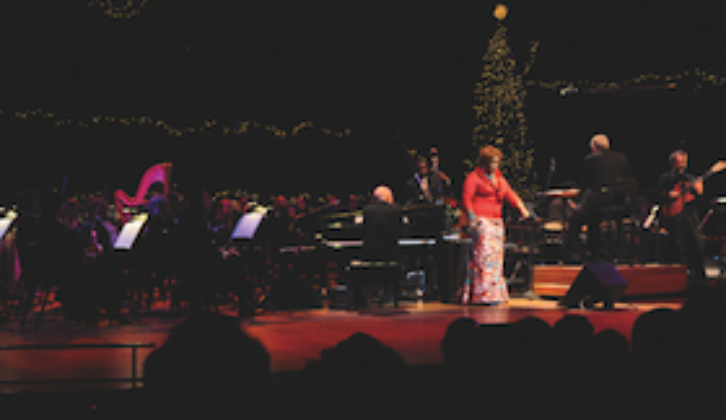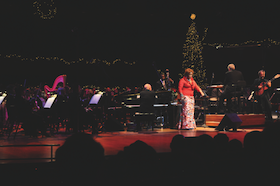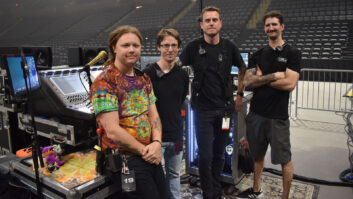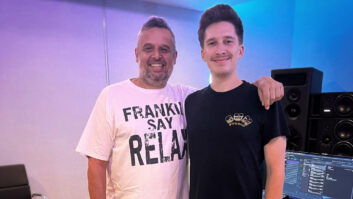

Dianne Reeves performing with the Colorado Symphony Orchestra and her quartet for a special jazz Christmas show that would later be broadcast in DTS surround to NPR stations.
A jazz quartet walks into a concert hall and meets a symphony orchestra. That’s not the opening line to a tall tale, but a concert put on at Boettcher Concert Hall in Denver on December 14, 2010. The Colorado Symphony Orchestra (CSO) and Marvin Hamlisch paired with Dianne Reeves and her quartet to put on a jazz Christmas show.
The show was recorded for later broadcast in DTS 5.1 on NPR by Mike Pappas and Thucydides “Duke” Marcos. Boettcher Hall is a tricky place to work in, with lots of shallow angles and an open, in-the-round feel. That presented a lot of challenges for Paul Boothe, Reeves’ sound engineer. Boothe has been working on sound engineering since the early 1980s, and has been with Reeves since 2004. Prior to that, he was with Michael Brecker.
“I started in 1983,” says Boothe. “Before that, I was a musician. In ’83, I was so hungry that I looked in the paper for a gig. I was a cellist in a rock band for many years, and cellists in rock bands have time to walk the house, so I was also doing sound from the stage—I thought I knew something about sound. I saw ‘Soundman Wanted’ in the paper, and the soundman who had the gig took pity on me. I was horrible; I had not a clue because I had worked on tiny 6-channel P.A.s. So I did that for a while, then was a production manager of a nightclub. It started out as a blues club, but you couldn’t make a living doing seven nights a week blues.

Reeve’s sound engineer, Paul Boothe, mans a DiGiCo SD7, using few effects off the board with the exception of some compression on Reeves’ vocals.
“I’d always had an affinity for jazz, and I met some artist managers as they came through this club in Cambridge, and I met a guy who I liked who was from the area and was managing Michael Brecker. He put me on a USIA tour with a small Bose P.A., and we went behind the Iron Curtain and did shows for the fans. It was a lot of work. That was my first one, and then a year later I got another of those. The second one had a pianist who I became friends with. Later, she was in a manager’s office who was managing a drummer named Tony Williams, and his road manager had called up while she was in the office about a Japanese tour. It was Tony Williams’ first time back to Japan in 40 years; he had some problems with the authorities on the Miles’ tour a long time ago, so it was his first time back and it was a big deal for the manager, and she was all up in arms, and my friend Rainey said, ‘Oh, I know a guy,’ and that was my last sound company gig. From that time on, I was doing audio and road managing. It’s a work in progress still.”
For the Reeves/Colorado Symphony Orchestra show, Pappas brought in a DiGiCo SD7 console with MADI capability. Although there were close to 100 microphones onstage, only about half of those were used for the broadcast while the others were used for sound reinforcement in the hall. The SD7 allowed Pappas and Boothe to split the feeds. Fine-tuning the SD7 before Boothe arrived was Aric Christensen, the house engineer for the Boettcher.
“It’s really set up well to do theater stuff,” says Christensen of the SD7. “You can set up each scene and have multiples within that scene. You can do stuff like change the delay settings of where a performer is. Let’s say they start at an upstage position; you can move to a scene after that where they are crossing so you can change the delay times and time-align your P.A. with where the performer is onstage. In an analog world, there’s no way of doing that. It’s really versatile.”

Handling monitor duties is Bret Dowlen (of Dowlen Sound), who is mixing on a Paragon P2 for the wedge-only stage musicians.
Boothe, who does “production du jour,” had some experience with the SD7, as well as the SD8, from previous tours in Europe. “We don’t travel with production at all,” he says. “We don’t even carry instruments. Guitar player carries a guitar, we carry cymbals, and that’s it. We have production du jour, backline du jour every day, and I’m blessed that I get to work with every desk that’s out there. The SD7 and SD8 are desks that I don’t work on a lot, but the ergonomics of them are friendly, unlike some. There hasn’t had to be a lot study. Of course, I don’t know the inner workings; the techs come in and take care of all the routing and all that so I don’t deal with much of the guts, the hardcore uses of the machine, but for the top layer it’s easy to move around on and it sounds good.”
Boothe didn’t use much in the way of effects on the SD7, except for some compression on Reeves’ vocal. The hall itself is difficult to mix in.
“Tonight, the room is the effect; I wish I had a reverb sucker,” Boothe says with a laugh. “I just finished doing a chamber orchestra tour with a pianist named Brad Mehldau, and he has a record out called The Highway Rider. We did a bunch of shows in Europe, and again it was production du jour. We had three orchestras on the tour but many nights in a row with the same orchestra, which helps, and I used the SD8 a couple of times over there. You’re not seeing another console that has the gang feature that has the sonic quality of the SD8. What a godsend that is.

Although there were close to 100 mics onstage, about half of those were used for the eventual broadcast in DTS 5.1; the others were used for SR in the hall.
“This room presents a lot of challenges,” Boothe continues. “The engineer here, Aric [Christensen], has done a great job balancing the P.A., so it’s made it really easy for me to come in and mix and be somewhat accurate. It’s a mono mix. Typically when I mix orchestras, and I typically do 30 orchestra shows a year, I do a lot of shameless panning because orchestras are that way acoustically; it’s not mono by any stretch. It helps when you can do that to reinforce an orchestra when you use hard panning of the mics. It’s a lot less demanding on the mix. You can get a lot more leeway, but when you have a mono mix of a whole orchestra and a band, that involves everyone coming out of the same speaker and you’ve got to multiply it all over the room. You have to really careful. Aric has done a good job of making that a possibility.”
One concession to carrying gear that Boothe makes is a Neumann KMS 105 microphone for Reeves, which he feels is one of the best for her dynamic vocal technique. “She has an incredible instrument—absolutely incredible, huge instrument,” he says. “And she uses the mic like a lot of other vocalists, but she has the instrument that can allow her to sing a foot-and-a-half to two feet off the microphone and not totally be a catastrophe. She will also get right up on the microphone, but she knows when to do that. She has really good microphone technique, but the 105 is one of the only microphones I’ve found that allows her to have that freedom.”
Reeves’ backing band included pianist Peter Martin, bassist Reginald Veal, drummer Terreon Gully and guitarist Peter Sprague, in addition to the CSO. The quartet required monitors, as did the orchestra’s percussion and the brass sections. In charge of mixing was Bret Dowlen of Dowlen Sound. The wedges were proprietary ones built by Dowlen Sound using a 12-inch and a 2-inch driver.
“Monitoring is on wedges for this application because that is what Dianne is most comfortable with,” Dowlen explains. “There are five out there for her and her musicians. It’s pretty simple; they’re not asking for much and they’re nice people so it’s been a good day.”
Dowlen mixes on a Paragon P2 desk, and found the mixing relatively simple as the musicians were not very demanding in what they wanted. “Wedges get louder than the orchestra, so the real challenge is trying to get them to be happy at much lower volumes than they might be happy with normally,” Dowlen says. “I kind of get the impression from the way they play together that they are jazz guys and listen to each other pretty well, and maybe monitors aren’t as critical to them as rock guys.
“Dianne’s getting her vocal, a little bit of piano and a tiny bit of guitar,” Dowlen continues. “The drummer really isn’t getting very much: a little bit of vocal, little bit of bass, little bit of guitar and a tiny bit of piano. The guitar player has a bit of her, some of the other vocals; they each sing on three songs so they each have a little bit of each other and themselves for when they sing. The piano player is getting a tiny bit of piano, a little bit of her and a tiny bit of guitar because they are kind of spaced far apart onstage. The bass player, he was the most particular of the bunch. I got his bass finally sounding the way he wanted it to, and we added a little bit of guitar and a tiny bit of Dianne, plus a tiny bit of the other guy’s vocals and tiny bit of his vocals, and that’s it for him.”
An estimated 1.5 million listeners heard the DTS Neural Surround broadcast on Christmas Eve 2010.
Candace Horgan is a Denver-based writer.


